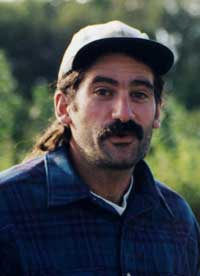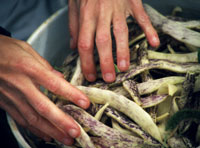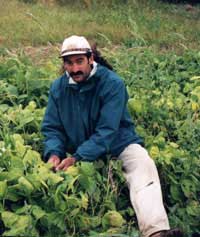It’s an overcast day outside of Stoughton, Wis., the village that claims to have invented the “kaffee break.” But a warm cup of java seems far, far away from Pleasant Hill Market Garden, where farmer Rob Baratz fights off the early morning, chilled wind with gritted teeth and a hand-rolled cigarette.

Baratz, up on the farm.
Brian Lavendel.
I find him out harvesting a few late strawberries, seemingly out of place on this early fall day. “It’s been a hard season,” he confesses, then quickly adds, “weatherwise, I mean.”
Baratz, 40, lives on the farm with his wife and nine-year-old son. He says he’s been challenged by a wet spring and droughty summer, but he knows he’s got it better than most of the family farmers in Wisconsin. The state is losing an average of 1,000 family farms each year to historically low milk and crop prices and cut-rate competition from factory farms.
Baratz has been able to avoid the pitfalls many of his fellow farmers face because his produce has a guaranteed market: Baratz is a Community Supported Agriculture farmer. CSA might be best described as farming, and eating, by subscription. In the CSA model, families pay a membership fee in exchange for a share of the farm’s production throughout the growing season.
Field Day
Pleasant Hill Farm has 55 member families, or “shares,” each of which pay him more than $400 in the spring. In exchange for their cash and a few hours of volunteer time, these member families receive a box of fresh produce each week.
For Baratz, it’s a big change from a career as a floor trader on the Chicago Stock Exchange. What prompted the switch from stock tickers and shiny floors to muddy boots and tractor parts? “I used to walk to the train station to catch the 6:08 to Chicago,” recalls Baratz. “But before I left, I liked to stand a minute looking at my garden. One day I decided I’d rather be doing that than getting on the train.” So Baratz and his wife packed up and left Chicago-land to head for the green pastures of Wisconsin.
Pleasant Hill Farm is the happy result. Today, a harvest day, a crew of a half-dozen paid and volunteer workers collect the farm’s bounty in crates and buckets. Once the harvest is in, Baratz determines how much of each item belongs to each share — if 120 pounds of tomatoes are picked, for example, each member family will receive two pounds of tomatoes this week. The vegetables are delivered to a central neighborhood location where members pick up their shares. Because subscribers don’t know what they’re going to get, it’s like vegetable Cracker Jack — a surprise in every box.

You say tomato.
Brian Lavendel.
Families benefit from this arrangement because they get local, fresh, organic produce grown by people they know and trust. As one member put it, the freshness of the food is unbeatable, “no comparison to store-bought.”
CSA members also get the opportunity to learn about where their food comes from, how it is grown, and what variables affect its production — insects, weather, and the like.
Baratz is sometimes surprised by how poorly informed Americans are. “Too many people don’t have a clue about where their food comes from,” he says. He tells the story of one woman who was unsure whether lettuce heads grew above or below ground.
Baratz, who discovered CSA farming after selling his produce at the local farmer’s market, is pleased with the approach. “With the CSA, you set it up, do your planning in winter, and by the time the season starts, you’ve got a home for your crops.”

Full of beans.
Brian Lavendel.
Still, it took him a while to get the hang of things. He recalls his first year as a CSA farmer, in which he planted far too much squash for his members. “After three weeks, people were saying ‘no more squash,'” he laughs. Every year, he’s figuring out new farming techniques, he says. “The more you know, the more you realize how much you don’t know.” For instance, this year, the potato crop was hard hit by dry weather. Baratz says he’ll be lucky to harvest half the quantity of potatoes he had hoped for.
But Baratz is quick to return to the advantages of the CSA model. “In any business, you’re trying to craft your own destiny. CSA gives peace of mind,” he says. Members help to absorb the risk from uncontrollable factors such as weather. If, for example, the farm experiences a particularly good or bad year, the shareholders simply receive more or less produce. In contrast, conventional farmers, such as those producing a cash crop for sale to a grain dealer, often shoulder the cost of crop failures.
Growing Pains
But even with the support of his members, Baratz struggles with the economics of farming. Unlike his neighbors who farm hundreds or even a couple thousand acres and whose income is calculated in dollars per bushel, Baratz has a mere seven acres in production.

Getting down and dirty
Brian Lavendel.
“We don’t have the economies of scale so we can’t buy lots of equipment,” says Baratz. The result is that most of the work, from planting to weeding to harvesting, is done by hand. And that means hours spent in the field. Asked how much he makes per hour, Baratz pauses for a moment, a handful of just-harvested beans in his hand. “Can’t be more than $5 before taxes,” he says. A harvester listening nearby laughs. “Before taxes?” But Baratz is serious.
He recalls meeting a fellow farmer at a CSA conference. “She said she made $5,000 or $6,000. I thought that was per acre. She said no, that was total. It broke my heart. Most consumers not only take food for granted, they take cheap food for granted,” says Baratz. “I ran the numbers and found that I’d have to charge $725 a share to make a decent living.”
Nonetheless, Baratz is hopeful. “I think CSAs will continue to see a lot of growth,” he predicts. In his first year as a CSA farmer, he was one of only six in the area. Today, more than two dozen CSA farms supply produce to the region. He sees the safety and security of organically grown produce as a benefit likely to continue attracting interest in the future. “A lot of parents are concerned about what their children eat. Have you read the ingredients on a box of Fruit Loops?” he asks before launching into a description of the chemical dyes found in processed cereal.
Better to stick with broccoli.



